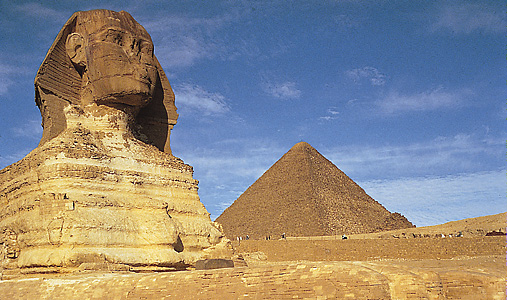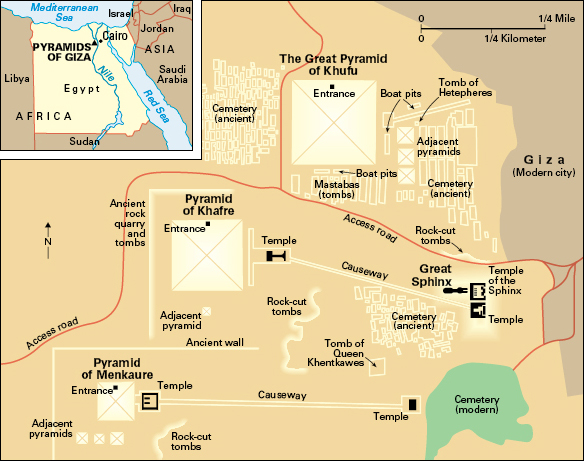Sphinx, << sfihngks, >> is an imaginary creature of ancient myths. The Egyptians, Greeks, and peoples of the Near East all had stories about such creatures. According to various tales, the sphinx had the body of a lion and the head of a human, falcon, or ram. Some sphinxes also had wings and a serpent tail.
The term sphinx is a Greek word that originally referred to an imaginary evil monster. The ancient Greeks used the term to describe the huge stone statues of lions with human heads that they saw during their visits to Egypt.
Egyptian sphinxes.
Most Egyptian sphinxes had the head of a man and the body, feet, and tail of a lion. Others had heads of rams or falcons. Egyptians often made statues of sphinxes to honor a king or queen. The sculptors modeled the face of such a sphinx after the honored person. Egyptian art frequently showed kings as lions conquering their enemies, and sphinxes became symbols of royal protection. Statues of sphinxes often lined avenues leading to temples, such as those near the great temple at Karnak. Other sphinxes represented the god Horus, the sky god and sun god who was thought to be a protector of the king.
The largest, oldest, and most famous sphinx statue lies in the desert near Giza, Egypt. It is called the Great Sphinx. The monument stretches 240 feet (73 meters) long and stands about 66 feet (20 meters) high. The width of its face measures 13 feet 8 inches (4.17 meters). Egyptians built the Great Sphinx about 4,500 years ago. They carved its head and body directly out of a giant rock in a limestone formation and cut stone blocks to form the paws and legs. This limestone formation had supplied much of the stone used to build several great pyramids. Loading the player...
Great Sphinx
The Great Sphinx wears a royal headdress and lies near the pyramid of King Khafre. Historians believe that the sphinx’s face is a portrait of Khafre, who probably had the monument built. 
Sand has often buried the Great Sphinx up to its neck. King Thutmose IV of Egypt (who ruled about 1400 to 1390 B.C.) cleared the sand away, supposedly after dreaming that the god Horus asked him to do so. During modern times, workers removed the sand in 1818, 1886, 1926, and 1938.

Through the years, desert sand, wind, rain, and sun have worn away part of the stone of the Great Sphinx. A broken section of the head indicates that it may have been used as a target for gun practice at various times. In the 1970’s, scientists began efforts to preserve the crumbling stone of the Great Sphinx by treating it with special chemicals.
The Greek sphinx
had the head of a woman, the body of a lion, a serpent tail, and wings. In the Greek myths, the most famous sphinx occurs in the story of Oedipus. The Sphinx lived on a high rock outside the city of Thebes. When anyone passed by, she asked a riddle: What has one voice and becomes four-footed, two-footed, and three-footed? The Sphinx destroyed everyone who could not answer correctly.
When Oedipus passed by on his way to Thebes, the Sphinx asked him the riddle. Oedipus replied: Man, who crawls on all fours as a baby, then walks on two legs, and finally needs a cane in old age. The Sphinx became furious because Oedipus had solved the riddle and jumped off the rock to her death.
Other sphinxes.
Pictures, sculptures, and statues of sphinxes existed in parts of the ancient world besides Egypt and Greece. For example, sphinxes have been found in the remains of such ancient civilizations as Assyria and Phoenicia in the Near East and those of Asia Minor (now part of Turkey). Many of these sphinxes were made of pottery or metal.
Like the Egyptians, other ancient peoples decorated tombs and temples with carvings or pictures of sphinxes. These ancient peoples probably intended the sphinxes to serve as guardians of sacred places.
